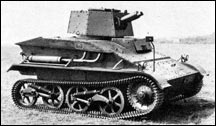| India’s
Armour
By Mike Bennighof, Ph.D.
December 2016
Mechanization came slowly to the British
Indian Army, as it did to many of the world’s
armed forces in the late 1930s. British units
had priority for tanks and motor vehicles,
though some units fielded “India Pattern”
light tanks by 1938. These machine-gun armed
tanks were already obsolete by most standards,
but British units were also still using similar
models and would take them into battle in
1939 and 1940.

The “India Pattern” light
tank, Mark I.
|
Indian infantry brigades served with distinction
in the Middle East, and a number of them appear
in our Gazala game, as does the Indian 3rd Motor Brigade.
Initially intended as part of an Indian armoured
division, this former cavalry brigade was
sent to the Western Desert in the spring of
1941, where it was overrun and destroyed by
German tanks. Withdrawn and reformed, it returned
to the desert just in time to be overrun and
destroyed by the Italian 132nd “Ariete”
Armored Division in the opening stages of
the Gazala battles.
Its intended parent division, the Indian
31st Armoured Division, had been raised in
July 1940 as the 1st Indian Armoured Division,
but no staff was assigned to its headquarters
until September. Initially it had two tank
brigades, designated 1st and 2nd Armoured,
and 3rd Motor Brigade. The division trained
extensively but with very few tanks —
the four tank battalions assigned to 1st Indian
Armoured Brigade had three M3 Stuart tanks
each, though a number of the obsolete India
Pattern light tanks were used for crew training.
Though lacking tanks, 2nd Armoured Brigade
was detached and sent to Iraq in January 1942
and re-designated 252nd Armoured Brigade.
Division headquarters moved to Iraq in June
1942, where it took command of the shattered
remnants of 3rd Indian Motor Brigade and the
252nd Indian Armoured Brigade, which still
had no tanks. 1st Armoured Brigade remained
in India.
Armor finally arrived in November, when
one battalion received M3 Stuart light tanks
and the other two received M3 Grant medium
tanks. Two of its battalions were Indian (the
Stuart-equipped 4th Duke of Cambridge’s
Own Lancers, known as Hodson’s Horse
and Grant-equipped 14th Prince of Wales’
Own Cavalry, the Scinde Horse) and the third
British (the 14/20th Hussars, equipped with
Grants). Soon afterward, 3rd Motor Brigade
received three new Gurkha battalions in place
of its old dismounted cavalry units, and was
re-designated 43rd Gurkha Lorried Infantry
Brigade.
The British command appears reluctant to
allow colonials of any color to function as
a modern, independent formation — the
Australian 1st Armoured Division was also
kept on a short allotment of tanks. India’s
tankers spent the war at home or on garrison
duty, with only a few small units seeing action
in Burma.

An M3 Grant tanks rolls through the
desert.
|
Thirty-First Armoured never saw action as a
unit, its closest brush with combat coming in
April 1944 when it was rushed to Egypt to crush
a mutiny among the Greek 1st Infantry Brigade.
The Indian tankers received Shermans in November
1943, apparently in preparation for transfer
to combat in Italy, but only drove them in Iraq,
Syria and Egypt. Their older tanks appear to
have been shipped back to India to equip the
still-tankless 251st Armoured Brigade (the original
1st Armoured Brigade).
The Gurkha brigade was detached in October
1944 and went to Italy, where it saw action
as an independent unit. Returning to India
at war’s end, 31st Armoured Division
was redesignated 1st Armoured in September
1945 and was allotted to India during the
partition of the British Indian Army two years
later. Soon afterward, it conducted the Indian
army’s first military operation, crushing
the small army of the princely state of Hyderabad,
which had resisted incorporation into India.
The division saw action in wars against Pakistan
in 1948, 1965 and 1971, and is again known
as 31st Armoured Division.
Though the Indian regiments were greatly
understrength in tanks, enough vehicles existed
in British depots in Egypt to flesh them out
to full strength. The division could easily
have been brought forward to participate in
the Gazala battles. Both sides planned to
attack, and the Axis only managed to beat
the Commonwealth to the punch by a matter
of days.
  
British armoured divisions at Gazala had
one armoured brigade, one infantry brigade
and one motor rifle battalion, the same paper
organization of 31st Armoured. The formation
consists of six units: division headquarters,
Bombay Grenadiers motorized infantry battalion,
3rd Motor Brigade, and three tank battalions:
Hodson’s Horse, Scinde Horse, and 14/20th
Lancers. In all scenarios, all of them set
up at or within one hex of hex 0814. 3rd Motor
Brigade is no longer assigned to 7th Armoured
Division, and 7/7 Infantry Brigade (4-1-9
strength) is placed in hex 1020. The British
begin with no Stuart or Grant replacements.
Click here to download the pieces.
Victory conditions remain unchanged, but
this new formation placed in the path of the
Axis advance will change play of the game
substantially. We don’t recommend using
this variant unless the
Littorio variant is also in play for the
Axis side.
Send India's tankers into battle! Order Gazala '42 right now.
Mike Bennighof is president of Avalanche Press and holds a doctorate in history from Emory University. A Fulbright Scholar and award-winning journalist, he has published over 100 books, games and articles on historical subjects.
He lives in Birmingham, Alabama with his wife, three children and his dog, Leopold.
|
